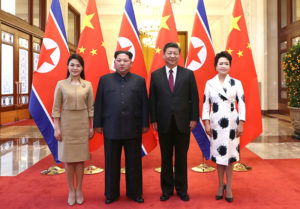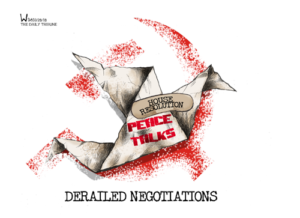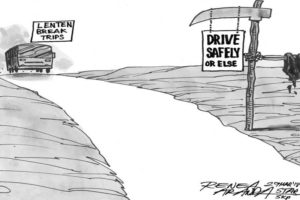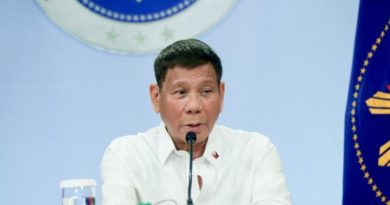OP-ED EDITORIAL: OPINION – ‘Cautious optimism on the Korean Peninsula’ & CARTOON -JANET NAPOLES’ “PABASA” – The Manila Times, Saturday March 31 2018
EDITORIAL
Cautious optimism on the Korean Peninsula

This Easter eve, there is reason to be optimistic about regional peace and global economic security.
Not long ago, the Korean Peninsula was a tinderbox about to explode as Washington and Pyongyang exchanged volleys of rhetoric and flexed their respective military muscles. As many have warned, a brewing war in the Korean peninsula could disrupt Asia’s economic growth, perhaps even the world’s. The Philippines would not be spared, and its main economic partners aside from the United States – China and Japan – would be dragged into the conflict.
Since the Winter Olympics, however, tensions have eased. North Korean athletes participated in the games with their brothers and sisters from the South. Later, the North’s Kim Jong-un offered to meet with US President Donald Trump, who has accepted it. More recently, reports say that Mr. Kim will also meet with President Moon Jae-in of the South in late April.
Moving forward, the Americans asked its allies to keep the pressure on North Korea to seek peace. The US carries on with its exercises with South Korea, which Pyongyang finds provocative. President Trump credits the unrelenting pressure on North Korea to be open to the possibility of peace talks. Whether or not that is true, the outcome is indisputable.
Even though North Korea has not conducted any new missile or nuclear test since before the Winter Games, Pyongyang still defies United Nations resolutions with utter disregard for the grave consequences. For instance, reports have it that North Korean ships were continuing mid-sea transfers of petroleum from tankers flying friendly flags, a way of getting around the UN oil embargo on Pyongyang. These risky actions could result in spillage or similar accidents that would harm the environment and imperil livelihoods. Also earlier this month, The Manila Times reported that Pyongyang was operating a nuclear power plant close to the Chinese border with little regard for safety, based on photos obtained from Getty Images and other reports. That plant could be another Chernobyl in the making.
In a recent dinner hosted by the South Korean ambassador to the Philippines for editors of this paper, the envoy suggested that Manila could also play a role in bridging the warring Koreas. Ambassador Han Dong-man mentioned the Philippines’ diplomatic ties with both Seoul and Pyongyang, where Manila’s envoy in Beijing is an accredited non-resident ambassador. But as we have pointed out before, the power that could intervene more effectively is China.
Beijing’s blessing
When North Korea’s Kim Jong-un appeared to be leaning toward war, the world called for China’s intervention. It is the North’s closest neighbor, and China is its largest trading partner and most reliable military ally.
That said, leaders in Beijing have repeatedly asserted that it could not rein in Mr. Kim. China, too, has expressed concerns about the missile and nuclear tests, but North Korea seems to ignore the Chinese, like it does everyone else on that issue.
Earlier this week, however, the world was surprised to learn of Mr. Kim’s unannounced visit to Beijing, his first trip outside his country since assuming power. The visit underscores China’s true significance and its potential contribution to peace in the Korean peninsula, nothwithstanding the observation that Beijing was at the margins in arranging the upcoming talks between Messrs. Kim and Trump. Remember that China chaired the six-party talks that collapsed in 2009, and Beijing’s calls to revive that have remained unanswered.
In Beijing, did North Korea seek China’s blessing on whatever Pyongyang would bring to the table with presidents Trump and Moon? Perhaps we shall see soon.
But as we have said before, peace talks on the Korean peninsula needed to take into consideration the security concerns of China. North Korea acts like a buffer to China, and few will disagree that it does not want US troops or a strong American ally at its border. For peace to be realized, China has to buy into the talks. And for the rest of the world including the Philippines, they must keep up the pressure until we see concrete and lasting results.
7.1. Gov’t terms should prevail – The Daily Tribune

7.2 Stop fighting first & the talks can resume – The Manila Bulletin
.
7.3. A cycle of violence – The Manila Standard


7.5. 10-year-old moms – The Philippine Daily Inquirer

.


8.1. Will Trump-Kim summit be a recipe for peace or war?– – For The Straits Times


Narushige Michishita-
Professor at the National Graduate Institute for Policy Studies in Tokyo. – For The Straits Times
VEERA PRATEEPCHAIKUL FORMER EDITOR
– The Bangkok Post

 NOTE : All photographs, news, editorials, opinions, information, data, others have been taken from the Internet ..aseanews.net | [email protected] |
NOTE : All photographs, news, editorials, opinions, information, data, others have been taken from the Internet ..aseanews.net | [email protected] |.For comments, Email to :
D’Equalizer | [email protected] | Contributor.










